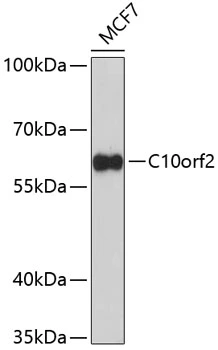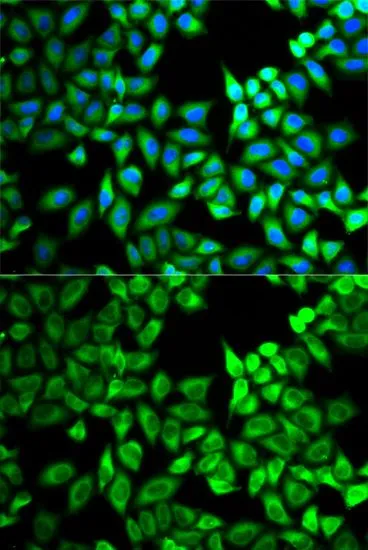
WB analysis of MCF7 cell lysate using GTX53922 Twinkle antibody. The signal was developed with ECL plus-Enhanced. Dilution : 1:1000 Loading : 25microg per lane
Twinkle antibody
GTX53922
ApplicationsImmunoFluorescence, Western Blot, ImmunoCytoChemistry
Product group Antibodies
ReactivityHuman
TargetTWNK
Overview
- SupplierGeneTex
- Product NameTwinkle antibody
- Delivery Days Customer7
- Application Supplier NoteWB: 1:500 - 1:2000. ICC/IF: 1:50 - 1:200. *Optimal dilutions/concentrations should be determined by the researcher.Not tested in other applications.
- ApplicationsImmunoFluorescence, Western Blot, ImmunoCytoChemistry
- CertificationResearch Use Only
- ClonalityPolyclonal
- ConjugateUnconjugated
- Gene ID56652
- Target nameTWNK
- Target descriptiontwinkle mtDNA helicase
- Target synonymsataxin 8; ATXN8; C10orf2; IOSCA; MTDPS7; PEO; PEO1; PEOA3; PRLTS5; progressive external ophthalmoplegia 1 protein; SANDO; SCA8; T7 gp4-like protein with intramitochondrial nucleoid localization; T7 helicase-related protein with intramitochondrial nucleoid localization; T7-like mitochondrial DNA helicase; twinkle protein, mitochondrial; TWINL
- HostRabbit
- IsotypeIgG
- Protein IDQ96RR1
- Protein NameTwinkle protein, mitochondrial
- Scientific DescriptionThis gene encodes a hexameric DNA helicase which unwinds short stretches of double-stranded DNA in the 5 to 3 direction and, along with mitochondrial single-stranded DNA binding protein and mtDNA polymerase gamma, is thought to play a key role in mtDNA replication. The protein localizes to the mitochondrial matrix and mitochondrial nucleoids. Mutations in this gene cause infantile onset spinocerebellar ataxia (IOSCA) and progressive external ophthalmoplegia (PEO) and are also associated with several mitochondrial depletion syndromes. Alternative splicing results in multiple transcript variants encoding distinct isoforms.[provided by RefSeq, Aug 2009]
- ReactivityHuman
- Storage Instruction-20°C or -80°C,2°C to 8°C
- UNSPSC12352203

